|
The displays, demonstrations and games in the Exhibit Hall
are designed to tell the story of how the Bell System, through
science and technology, has in the past and will continue to
make communicating easier and better for everyone, everywhere.
The following describes the major areas of the Exhibit:
|
| Creatures and Man Area. This
display consists of a series of light boxes and copy blocks --
pictures of creatures of land, sea and air -- as well as photographs
of some of man's accomplishments in communications. The story
told is that essentially all creatures communicate. Some have
more highly developed senses than man, but man because he can
think and reason has developed his ability to communicate to
a far greater degree than any other form of life. |
|
Senses Area. Here, speech,
vision and hearing are examined. There are two major exhibits
-- a demonstration of Visible Speech and Voice Prints, and one
of Artificial Larynx and the Vocoder.
Because the voice is transmitted on the telephone, Bell has
devised ways of studying it. The Visible Speech Translator shows
us the sounds of the voice on a television screen.
The Visible Speech exhibit features an isolation booth in
which a volunteer from the audience reads a sentence. His speech
patterns appear to the audience on a television screen.
The Artificial Larynx is demonstrated as the Bell Telephone
Laboratories invention which restores the gift of speech to those
who have lost their vocal chords.
-
Artificial Larynx demonstration
(Photo courtesy of Bradd Schiffman)
-
Source: A.T.
& T. Archives Photo
|
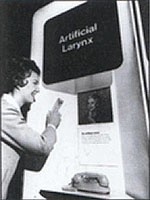
|
In the Vocoder exhibit it is shown how this experimental machine
samples the voice, selecting only parts for transmission and
reconstructing them into a complete conversation at the receiving
end. It will actually be demonstrated how your voice can be taken
apart and put back together again.
One wall includes an animated display of the ear, eye and
throat, explaining how they function. The visitor is also able
to test his skill at pitch matching, and to participate in an
optical illusion game.
-
Senses Wall in the Bell System's
pavilion. Approximately 14 by 40 feet, it depicts what takes
place in hearing, speaking and seeing. Sound waves are shown
in motion through the medium of Technamation.
-
Source: Industrial
Photography, Vol. 13 No. 5, May 1964
|
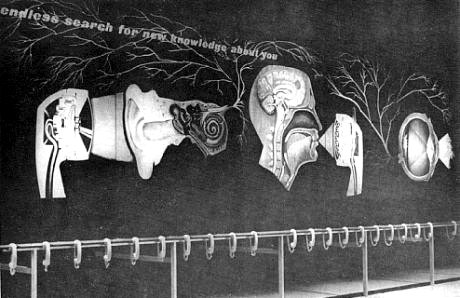
|
-
Source: Monsanto
Magazine, Summer, 1964
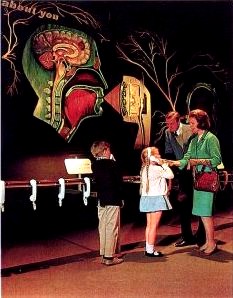 |
|
| Telephone of Today and Vision.
Two displays make up this area. They demonstrate some of the
products of over 80 years of Bell System research. The first
display explains the development of telephone instruments and
services from our earliest offerings to the modern instruments
and services. The second exhibit demonstrates how research in
the area of vision has enabled us to gain knowledge in areas
where we were once unable to see. It ranges in scope from the
electronic microscope to the radio telescope |
| Basic Science Exhibit. The
major display in this area demonstrates crystal growth. It is
supported with displays of the dramatic developments that have
been made possible by knowledge acquired through research on
the structure of crystals -- the transistor, solar battery, Maser
and Laser. One wall is devoted to a display of the dramatic impact
on our lives that has resulted from these inventions, namely
miniaturization of electronic equipment, use in satellites, computers,
transmission, radio and television equipment, etc. |
|
Waves Exhibit. The waves
exhibit features a Torsional Wave Machine that demonstrates the
behavior of waves. It is demonstrated that waves carry information
and that this fact makes it possible to transmit voice, music
and television over great distances.
Supporting displays show the various transmission media --
cable, coaxial cable, wave guide, microwave, Maser and Laser.
|
|
Tasi Complexity Exhibit.
This exhibit shows the underseas cable routes and how they operate.
The Tasi demonstration explains how utilization of these routes
is almost doubled by using the silent times occurring in a conversation
(e.g., time spent listening, thinking or pauses) to transmit
parts of another conversation. In the foreseeable future, the
Vocoder, demonstrated in the Senses Area, will be used in conjunction
with Tasi to more than quadruple the information-carrying capacity
of the underseas cable.
In support of these exhibits, there are logic and memory games
in which the audience may participate. There is an age-guessing
game, a Roman numeral translator and a Tic-Tac-Toe game.
-
Hostess Ruth Gola gives Sally Winternitz
a live demonstration on the speed of Direct Distance Dialing
with a call to a recorded weather announcement in a distant city.
-
Source: A.T.&
T. Archives Photo
|
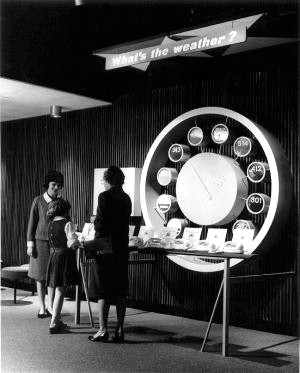
|
|
|
Picturephone (Television Telephone).
Here the audience participates in an actual research project
conducted by the Bell Telephone Laboratories on TV telephones.
There are six picture telephones in this area which are interconnected
so that a participant may use any one to see and speak with any
one of the others. Bell Laboratories staff members interview
participants to determine such things as what kind of picture
phone instruments they would desire, what kinds of services they
would like it to perform, how they would use it, what the value
of a service of this kind would be to them, etc.
-
Picturephone in use at the Bell System
(Photo courtesy of Bradd Schiffman)
-
Source: A.T.&
T. Archives Photo
|
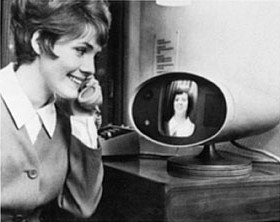
|
|
|
Data Exhibit. This exhibit
demonstrates the services offered by the Bell System that makes
it possible for machines to talk to machines. It emphasizes many
of the ways that information may be passed between machines and
the tremendous speeds of transmission made possible through the
use of this medium.
-
Dataphone Exhibit
-
Source: A.T.&
T. Archives Photo
|
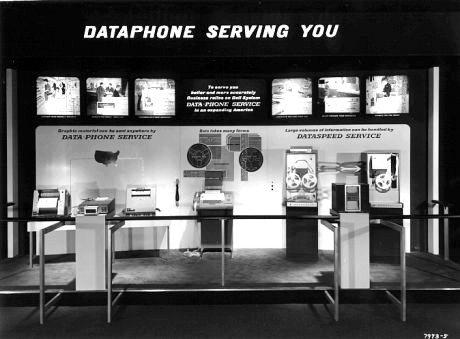
|
|
|
Network. In a pyrotechnic-like
display of moving multi-colored light on a treated plexi-glass
wall that wraps almost halfway around a circular theater, the
Network Story is told. In forty steps the story builds from a
single call into the nationwide network. Data, the Defense Lines,
the Cable and Microwave Systems all combine into one vast network
which then expands into its world-wide capability, and, with
the effect of a shrinking world, will ultimately evolve the extension
of the network into space through satellites and the Maser or
Laser.
-
Model of the Telstar Communications
Satellite on display (Photo
courtesy of Bradd Schiffman)
-
Source: Official
Guide - New York World's Fair, 1964 Edition, Time-Life Books,
publisher
|
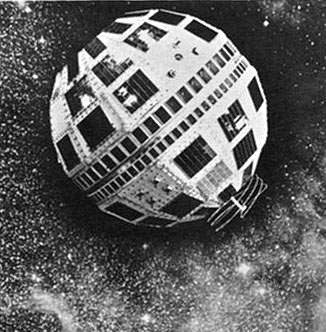
|
|
TIC-TAC-TOE MACHINE
|
You can play a game of tic-tac-toe with a machine developed
by William Keister of Bell Telephone Laboratories, but don't
expect to win. The machine can be tied but cannot be beaten.
The machine represents the kinds of processes that can be built
into telephone systems. It illustrates how relay-type equipment
(like that used in telephone systems) makes logical decisions
in connecting one caller with another.
The face of the cabinet is divided into nine squares. When
you press a button near one of the squares to light it with a
figure, such as "x", the machine automatically places
the other symbol, in this case an "o", in another square
and waits its turn for another play. The electro-mechanical brain
can make three decisions. If you succeed in marking two symbols
in a row, the machine makes a defensive play by filling in the
third space in the row. If the machine itself has two in a row,
it will fill in the third and win. If there is no immediate chance
to win and no need to block you from winning, the machine marks
the most advantageous square.
No matter how good you are, the best you can hope for is a
draw.
|
Source Book "Science
at the Fair"
|
A pair of youngsters
and hostess Diana Janukatys
at the Bell System exhibit await an answer from a favorite cartoon
character they have dialed at the kiddie telephone center. P.S.
they got a recorded message.
Source: News
Colorfoto by Edmund Peters and Richard Lewis, New York Sunday
News, May 23, 1965
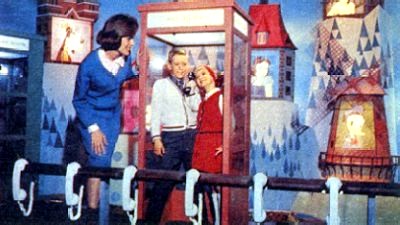 |
|
|
Webmaster's note... As is often the case, these "Feature"
stories on the exhibits at the Fair involve the contributions
of many people. I am so thankful for the materials that others
contribute because of how much they add to these presentations.
In the case of the Bell Feature, I'd like to especially thank
Tom Wentland for the Bethlehem Steel reprint that explains the
construction of the pavilion. Bradd Schiffman contributed many
of the pictures that you see throughout the story. And my thanks
to Ray Dashner for his recording of the 1965 version of The
Ride of Communications which I was able to transcribe to
complement the '64 version that I've had for many years. Thanks
to everyone who helped to remember this wonderful exhibit.
- Bill Young
- October, 2001
|
|